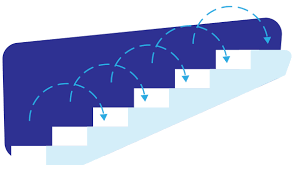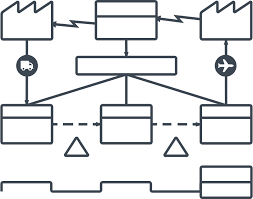February 2019 LEAN Newsletter 3
- Countdown to LEAN 1 - Elimination of Waste
- Countdown to LEAN 2
- Big Picture Thinking
- Continuous Improvement
- Value Stream Mapping
Big Picture Thinking
 Thinking back to the first newsletter--with its focus on the different types of waste--and the second newsletter—speaking to visibility and transparency of systems, this final newsletter is focusing on the LEAN philosophy of strategy and planning.
Thinking back to the first newsletter--with its focus on the different types of waste--and the second newsletter—speaking to visibility and transparency of systems, this final newsletter is focusing on the LEAN philosophy of strategy and planning.
If we think strategically about all these different components together, it enables us to incorporate long-term planning into everyday operations.
 The Senate Office’s success – as with any organization – is a combination of day-to-day activities with long-term planning. Sometimes we can get so consumed with daily operations that we lose sight of where we’re headed, or changes that we need to make in order to get there with ease.
The Senate Office’s success – as with any organization – is a combination of day-to-day activities with long-term planning. Sometimes we can get so consumed with daily operations that we lose sight of where we’re headed, or changes that we need to make in order to get there with ease.
This approach helps us to put shorter-term development into context and with perspective towards maintaining a competitive advantage within UCSF. If all of UCSF is moving towards a LEANer environment, what would it look like if we did?
Conceptually, the broad view approach can be implemented by matching operational tasks and decisions with strategic goals and avoiding tunnel vision. The latter results in an overemphasis on product and process rather than on the combined “client” (faculty the Senate represents). Within the office this can result in missed steps in process – because an individual analyst may ‘think’ they’ve done everything accurately but without thinking of the bigger picture, they may have missed something. This is especially apparent in new committee initiatives and policies, where analysts do not always have a consistent set of guidelines or exemplar to follow.
Another example within the office might be, analysts silo-ing themselves in day-to-day activities without emerging to discuss with colleagues if there’s any cross-pollination or partnership which could occur between committees. This could be aided by more conversations between analysts about their work with different committees, or a Smartsheet detailing committee work-in-progress activities.
This process creates a “checks and balances” environment that not only keeps the organization on track with its long-term strategy but also gives on-the-ground analysts a structure for decision-making. Analysts can weigh shorter-term actions against the office’s long-term strategy. This helps to minimize waste created by analysts having to pivot focus and conduct wasteful overwork leading to unevenness in work effort. Examples of long term strategy work that our office has done in the past year include developing a UCSF Compendium and the Legislative Modification Job Aide.
In conjunction with visibility, a LEAN organization that utilizes this broad view approach should consider its operations as a network instead of numerous singular committees/councils and committee relationships.
Continuous Improvement
The concept of continuous improvement makes for a work culture that is receptive to change. Combined LEAN components create a foundation for an organization that allows for tireless self-improvement.
 But tireless can be…tiring. So combined with such an approach should be respect for others and an acknowledgement of everyone’s efforts, that will if nothing else bring forth people’s strengths and cultivate a culture of appreciation.
But tireless can be…tiring. So combined with such an approach should be respect for others and an acknowledgement of everyone’s efforts, that will if nothing else bring forth people’s strengths and cultivate a culture of appreciation.
The process of continuous improvement is cyclical, known in shorthand as PDCA – plan, do, check, adjust – or also the Deming cycle, or the Shewhart cycle. In each step, the objective and method remain the same, but with slight variations based on the specific topic.
- Planning encompasses establishing objectives and methods for reaching those objectives or goals.
- Do equals the execution of the plan. Data collection at this stage is necessary for the next two stages and to measure goal achievement throughout. As an analyst, there is not always an easy way to find and acquire data. However, data can be as simple as number of emails sent, amount of time spent, or number of attendees at an event.
- Checking compares the data collected in the prior step against the results, and more importantly, the goals established at the planning stage.
- If variation is found at the check phase – leading to unexpected positive or negative consequences – then the initial plan can be adjusted. Precise corrective action should be implemented only after the source of the variation is confirmed and such actions should be targeted to work in partnership with goal achievement.
What if a PCDA approach doesn’t produce intended solutions? A next step – which we won’t go into here beyond an overview – is A3 Problem Solving or Systematic Problem Solving (SPS). This seven-step problem solving examines:
- Initial perceptions of the problem
- Breaks down the problem
- Focuses on a targeted goal
- Performs root cause analysis
- Enacts corrective action
- Analysis of the corrective action determines success of the SPS.
- Depending on the analysis, follow-up action is taken usually in the form of a communication.
If SPS wasn’t successful either, then a further investigation into the root cause of the problem may be required.
Value Stream Mapping
 LEAN defines a value stream as the total sum of effort, operations, processes, and production that contributes to the creation of value for a customer. It starts with the client (faculty) and works backwards through the supply chain to the point of origin.
LEAN defines a value stream as the total sum of effort, operations, processes, and production that contributes to the creation of value for a customer. It starts with the client (faculty) and works backwards through the supply chain to the point of origin.
Value Stream Mapping (VSM) is a LEAN toolkit that is used to assess the current state of all activities and processes associated with production operations. The application of VSM is designed to highlight areas where improvement is possible, and to differentiate value-added activities from waste, all while establishing a baseline against which future improvement activities can be measured.
An initial VSM, developed by Senate Analyst Lillian Fine, of the annual process involved with the Senate’s Chancellor’s Funds is attached. We know that this project will be part of the LEAN training and analysis this spring 2019. We fully expect that this initial VSM will be revised, especially as we examine when the true start of the annual process should be.
Health Sciences Compensation Plan
Created by UC Board of Regents Standing Order 105, the UC San Francisco (UCSF) Academic Senate is empowered to exercise direct control over such academic matters as admissions for degrees and curricula, which are of central importance to the University. The UCSF Division of Academic Senate provides an independent forum to discuss faculty-related campus wide academic concerns. In other areas, the Senate exercises an active advisory role. The Academic Senate works within the larger body of UCSF, a leading university dedicated to promoting health worldwide through advanced biomedical research, graduate-level education in the life sciences and health professions, and excellence in patient care.
